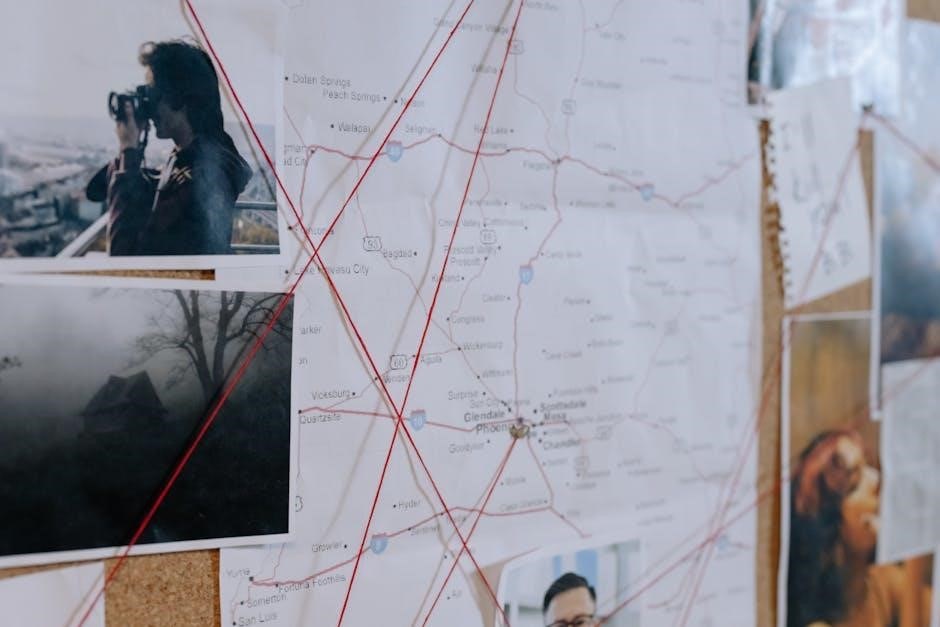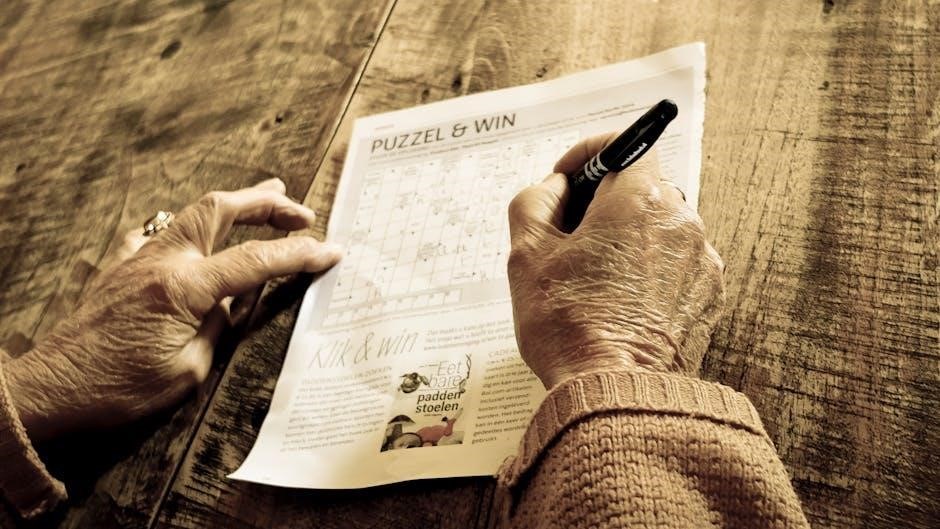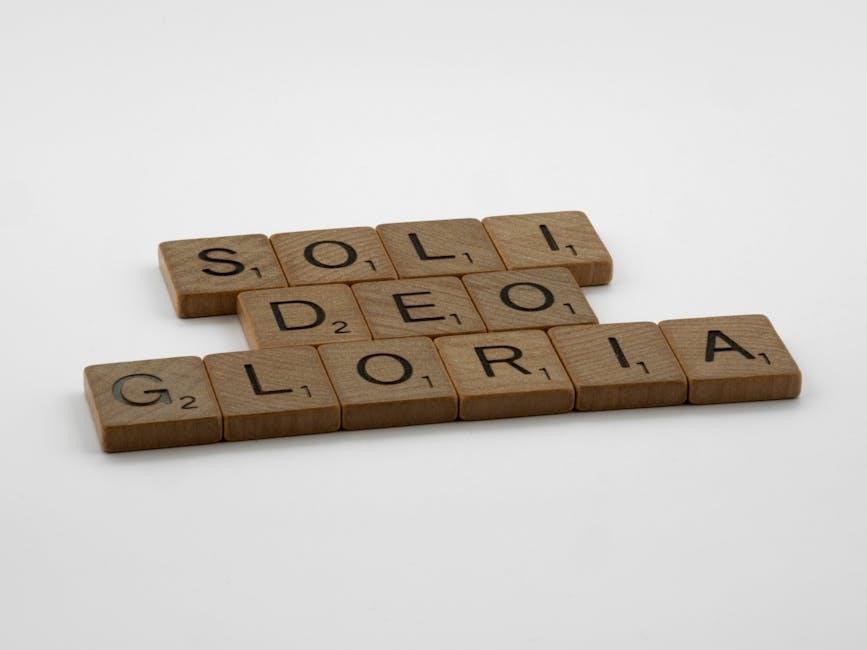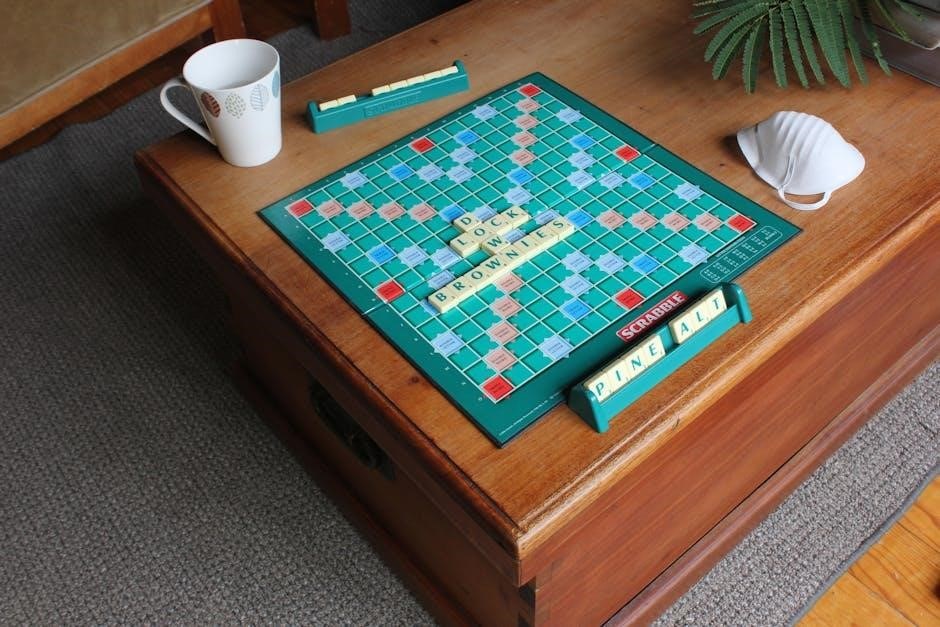The Scientific Method Crossword Puzzle is an engaging‚ interactive tool designed to help students and educators explore key concepts of the scientific method. By solving clues related to hypotheses‚ experiments‚ and conclusions‚ learners gain a deeper understanding of the process while improving vocabulary and critical thinking. This resource is ideal for classrooms and self-study‚ offering a fun way to master essential scientific terminology and principles.
1.1 Purpose of the Crossword Puzzle
The primary purpose of the Scientific Method Crossword Puzzle is to reinforce understanding of key concepts and terminology associated with the scientific method. By engaging with the puzzle‚ students can assess their knowledge‚ identify gaps‚ and strengthen retention of essential terms like “hypothesis‚” “experiment‚” and “conclusion.” The interactive nature of the puzzle makes learning fun and accessible‚ encouraging active participation and critical thinking. Additionally‚ it serves as a valuable tool for educators to evaluate student comprehension and provide targeted feedback. The inclusion of an answer key ensures accuracy and supports self-directed learning‚ making it a versatile resource for both classrooms and independent study.
1.2 Importance of the Scientific Method in Education
The scientific method is a cornerstone of education‚ fostering critical thinking‚ problem-solving‚ and logical reasoning. It equips students with a systematic approach to exploring questions‚ conducting experiments‚ and analyzing data. By mastering the scientific method‚ learners develop skills essential for academic success and real-world applications. Integrating it into curricula ensures students can think scientifically‚ evaluate evidence‚ and draw informed conclusions. This foundational knowledge prepares them for advanced studies in STEM fields and fosters a mindset of curiosity and innovation‚ essential for addressing global challenges and contributing to societal progress.
1.3 How Crossword Puzzles Enhance Learning
Crossword puzzles are an engaging and interactive way to reinforce learning‚ particularly for scientific method concepts. They enhance vocabulary retention by introducing key terms in a fun‚ challenging format. Solving clues promotes problem-solving skills and critical thinking‚ as learners must analyze and connect words to their meanings. Crosswords also encourage active learning‚ making complex topics more accessible and memorable. By engaging with content in this way‚ students develop a deeper understanding of the scientific method while improving their overall cognitive skills. This interactive approach fosters a enjoyable and effective learning experience‚ making it ideal for educational settings.

Key Components of the Scientific Method
The scientific method involves observation‚ questioning‚ research‚ hypothesis formation‚ experimentation‚ data analysis‚ and conclusion. These steps guide systematic investigation‚ fostering critical thinking and problem-solving skills essential in science.
2.1 Step 1: Make an Observation
Making an observation is the first step in the scientific method‚ involving the use of senses to gather information about the environment. This step is crucial for identifying patterns‚ raising questions‚ and forming hypotheses. In the context of a crossword puzzle‚ clues related to observation might include terms like “data collection” or “evidence.” By incorporating such vocabulary‚ the puzzle reinforces the importance of careful observation in scientific inquiry‚ helping learners connect practical observations with theoretical concepts. This foundational step encourages curiosity and sets the stage for further investigation and experimentation.
2.2 Step 2: Ask a Question
After making observations‚ the next step in the scientific method is to ask a question. This question should be specific‚ focused‚ and testable‚ guiding further research and experimentation. In a crossword puzzle‚ clues related to this step might include terms like “inquiry” or “query.” Asking a question helps narrow down the scope of investigation‚ ensuring that the subsequent steps are purposeful and directed. This critical thinking process encourages learners to think deeply about their observations and formulate hypotheses to test their ideas. It bridges the gap between curiosity and systematic exploration‚ fostering a deeper understanding of scientific principles. Crossword puzzles reinforce this step by incorporating relevant vocabulary‚ making learning interactive and engaging.
2.3 Step 3: Research the Topic
Researching the topic is a crucial step in the scientific method‚ allowing scientists to gather background information and understand existing knowledge. This step involves reading books‚ articles‚ and studies to gain insights into the subject. Crossword puzzles often include terms like “background information” or “investigation” to highlight this process. By conducting thorough research‚ scientists can identify patterns‚ unanswered questions‚ and areas for further exploration. This step provides a foundation for forming hypotheses and designing experiments‚ ensuring that the investigation is informed and focused. Crossword clues related to research emphasize the importance of this step in building a strong scientific framework.
2.4 Step 4: Hypothesis
A hypothesis is an educated guess that attempts to explain the observations made during the research phase. It is a testable statement that predicts the outcome of an experiment. In crossword puzzles‚ terms like “educated guess” or “prediction” often relate to this step. A strong hypothesis is specific and measurable‚ guiding the design of experiments to test its validity. Crossword clues may focus on keywords such as “hypothesis” or “prediction‚” emphasizing the importance of this step in the scientific method. By formulating a clear hypothesis‚ scientists can systematically test their ideas and refine their understanding of the phenomenon under investigation.
2.5 Step 5: Experiment
The experiment is the practical phase where the hypothesis is tested. It involves collecting data by manipulating variables and observing outcomes. Crossword puzzles often use terms like “test” or “trial” to describe this step. A well-designed experiment includes clear procedures‚ controlled variables‚ and accurate measurements. Clues might reference “procedure” or “data collection‚” highlighting the methodical nature of this stage. By conducting experiments‚ scientists can determine whether their hypothesis is supported or rejected‚ leading to further analysis and refinement of their ideas. This step is crucial for validating the scientific method and drawing meaningful conclusions.
2.6 Step 6: Analyze Data
Analyzing data is a critical step where scientists interpret the results of their experiments. This involves examining patterns‚ trends‚ and correlations to determine if the data supports the hypothesis. Crossword clues often use terms like “interpret” or “evaluate” to describe this process. Accurate analysis ensures that conclusions are drawn logically and objectively. If the data aligns with the hypothesis‚ it may lead to validation; otherwise‚ further investigation or refinement of the hypothesis is needed. This step reinforces the importance of careful observation and precise measurement in scientific inquiry‚ making it a cornerstone of the scientific method.
2.7 Step 7: Conclusion
The conclusion is the final step in the scientific method‚ where scientists summarize their findings and determine whether the data supports their hypothesis. Crossword puzzles often use terms like “final step” or “summary of results” to describe this phase. A strong conclusion clearly states whether the hypothesis was proven‚ disproven‚ or needs further testing. It also highlights the implications of the findings and suggests potential areas for future research. This step reinforces the importance of clear communication and logical reasoning in scientific inquiry‚ ensuring that the results are presented coherently and effectively.

Crossword Puzzle Clues and Answers
This section provides a comprehensive list of clues and answers tailored to the scientific method‚ helping learners engage with key concepts in an interactive way. Each clue is carefully crafted to test knowledge of terms like “hypothesis‚” “experiment‚” and “variable‚” while the answers ensure clarity and understanding. The crossword puzzle is designed to reinforce learning through fun and challenging wordplay‚ making it an effective tool for education. PDF resources are also available for easy access and printing.
3.1 Clue: “The part of an experiment not being tested”
The answer to this clue is “control.” In the scientific method‚ the control refers to the part of an experiment that remains unchanged and is used as a baseline for comparison. It helps scientists determine the effect of the variable being tested. For example‚ in an experiment testing the impact of light on plant growth‚ the control group would be plants kept in darkness. This concept is fundamental to ensuring the validity of experimental results and is a key term in scientific vocabulary. The crossword puzzle reinforces this concept through interactive wordplay‚ making it easier for learners to remember this essential idea. The “control” is a critical component of any well-designed experiment‚ ensuring that the results are accurate and reliable. By including this term in the crossword‚ students are encouraged to think about the structure of experiments and the importance of comparison in scientific inquiry.
3.2 Clue: “Steps used during an experiment”
The answer to this clue is “procedure.” In the scientific method‚ the procedure refers to the systematic steps taken to conduct an experiment. These steps are carefully planned and documented to ensure the experiment is conducted fairly and consistently. By following a clear procedure‚ scientists can minimize errors and ensure the reliability of their results. The crossword puzzle highlights this term to emphasize its importance in the experimental process. Understanding the procedure helps students grasp how experiments are structured and executed‚ making it a vital concept in science education. This interactive learning tool reinforces key terminology for better retention and understanding.
3.3 Clue: “Summary of the experiment and results”
The answer to this clue is “conclusion.” In the scientific method‚ the conclusion is the final step where scientists summarize their experiment and results. This is where they interpret the data collected‚ determine whether the hypothesis was supported or rejected‚ and draw meaningful insights. The conclusion provides a clear overview of the experiment’s outcomes and their implications. Including this term in the crossword puzzle helps learners understand the importance of summarizing findings‚ a crucial skill in scientific communication. This interactive approach reinforces key concepts and terminology‚ making learning engaging and effective for students of all levels. The crossword puzzle is a valuable educational tool that enhances retention and understanding of the scientific process.
3.4 Clue: “Variable in an experiment”
A variable in an experiment is a factor that can change or be controlled. It is a key element in scientific investigations‚ helping scientists understand cause-and-effect relationships. In the crossword puzzle‚ this term is often represented by words like “variable” or “factor.” Variables are categorized into independent (manipulated)‚ dependent (observed)‚ and controlled (kept constant). Understanding variables is crucial for designing valid experiments and drawing accurate conclusions. Including this term in the crossword puzzle reinforces the concept‚ making it easier for learners to grasp its importance in the scientific method and experimental design. This interactive approach enhances retention and understanding of scientific principles.
3.5 Clue: “Final step in the scientific method”

Benefits of Using Crossword Puzzles in Learning
Crossword puzzles enhance vocabulary retention‚ improve problem-solving skills‚ and promote active engagement with scientific concepts. They make learning interactive and fun‚ reinforcing key terms and concepts effectively.
4.1 Improved Vocabulary Retention
Crossword puzzles significantly enhance vocabulary retention by engaging learners in an interactive and memorable way. Solving clues related to the scientific method encourages repeated exposure to key terms‚ reinforcing their meanings. This active learning approach helps students connect words with their definitions‚ making retention more effective than passive reading. The structured format of crosswords also promotes better organization of knowledge‚ ensuring that scientific terminology is not only learned but also easily recalled. Over time‚ this leads to a stronger command of the subject matter and improved performance in related tasks.
4.2 Enhanced Problem-Solving Skills
Solving crossword puzzles enhances problem-solving skills by challenging learners to think critically and logically. Each clue requires careful analysis and connection to prior knowledge‚ mirroring the analytical processes used in scientific inquiry. As students navigate the puzzle‚ they develop the ability to approach complex questions systematically‚ a skill essential for conducting experiments and drawing conclusions. The interactive nature of crosswords fosters creativity and persistence‚ traits that are invaluable in both academic and real-world problem-solving scenarios. This engaging method helps students build confidence in their ability to tackle challenges and apply scientific reasoning effectively.
4.3 Active Learning Engagement
Scientific method crossword puzzles foster active learning by engaging students in an interactive and hands-on experience. Unlike passive learning methods‚ crosswords require students to actively read clues‚ think critically‚ and fill in answers‚ promoting mental participation. This approach encourages students to take control of their learning process‚ making it more dynamic and enjoyable. By solving clues‚ learners develop a deeper connection to the material‚ as they must apply their knowledge of scientific concepts to complete the puzzle. This active engagement not only enhances retention but also motivates students to explore and understand the scientific method more thoroughly.

Creating a Scientific Method Crossword Puzzle
Creating a scientific method crossword puzzle involves selecting relevant terms‚ designing a grid layout‚ and crafting clear clues. This tool aids in teaching vocabulary and concepts effectively.

5.1 Choosing Relevant Vocabulary
5.2 Designing the Puzzle Layout
Designing the puzzle layout involves creating a grid that balances simplicity and complexity. A symmetrical grid is often preferred for clarity. Start by placing high-priority terms like hypothesis and experiment in central or prominent positions. Ensure words intersect logically‚ with shared letters connecting related concepts. Avoid overly complex patterns that might frustrate solvers. The layout should accommodate varying word lengths and ensure readability. Proper spacing and numbering are essential for easy navigation. A well-designed layout enhances the learning experience‚ making the crossword both fun and educational.
5.3 Writing Effective Clues
Writing effective clues for a scientific method crossword puzzle requires clarity and precision. Clues should be concise yet descriptive‚ guiding solvers to the correct answers without being overly obvious. Use synonyms or related phrases to avoid direct repetition of terms. For example‚ instead of “A variable in an experiment‚” consider “A factor that can change in an experiment.” Ensure clues are unique to each term and avoid overlap with other sections. Incorporate action words or analogies to add variety and challenge‚ such as “What remains unchanged in an experiment?” for “control.” This approach enhances engagement and learning while maintaining the puzzle’s educational value.
Answer Key for the Scientific Method Crossword Puzzle
The answer key provides clear solutions to all clues‚ ensuring accuracy and understanding. It includes both across and down answers‚ making it easy to verify responses and reinforce learning.
6.1 Across Clues and Answers
Across Clues and Answers provides a comprehensive list of solutions for the horizontal entries in the Scientific Method Crossword Puzzle. Each clue is paired with its corresponding answer‚ ensuring clarity and ease of verification. For example‚ the clue “Part of an experiment not being tested” corresponds to “Control‚” while “Final step in the scientific method” matches “Conclusion.” This section is designed to help users quickly identify correct answers‚ reinforcing their understanding of key scientific terms and concepts. It serves as a valuable resource for both students and educators aiming to master the scientific method.
6.2 Down Clues and Answers
Down Clues and Answers complements the Across section by providing solutions for the vertical entries in the Scientific Method Crossword Puzzle. Each downward clue is paired with its correct answer‚ offering a clear reference for users. For instance‚ the clue “Steps used during an experiment” aligns with “Procedure‚” and “Summary of the experiment and results” corresponds to “Conclusion.” This section ensures that all vertical answers are easily verifiable‚ aiding in the learning process and reinforcing knowledge of essential scientific terminology and processes. It is an indispensable tool for anyone seeking to understand and apply the scientific method effectively.

Common Mistakes in Solving Crossword Puzzles
Common mistakes include misinterpreting clues‚ overlooking obvious answers‚ and not utilizing word overlaps‚ which can hinder progress in solving crossword puzzles effectively.
7.1 Misinterpreting Clues
Misinterpreting clues is a common pitfall when solving crossword puzzles. Clues often contain clever wordplay or ambiguous meanings‚ leading to incorrect answers. For instance‚ a clue might use a homophone or a double entendre‚ causing confusion. Additionally‚ clues may reference specific terminology or concepts from the scientific method‚ such as “hypothesis” or “control group‚” which can be easily misunderstood without proper context. To avoid this‚ solvers should carefully analyze each clue‚ consider multiple interpretations‚ and cross-reference with intersecting words in the puzzle. This strategy helps ensure accuracy and prevents wasted time on incorrect solutions.
7.2 Overlooking Obvious Answers
Overlooking obvious answers is a frequent mistake in crossword puzzles. Solvers often focus on complex clues and neglect straightforward ones‚ leading to missed opportunities. For example‚ a clue like “The first step in the scientific method” might be “observation‚” but if the solver is distracted by harder clues‚ they might skip it. Additionally‚ obvious answers may seem too simple‚ causing doubt. To avoid this‚ solvers should start with easier clues‚ fill in known terms like “hypothesis” or “control‚” and systematically review the grid to ensure no simple answers are missed. This approach helps build momentum and reduces errors.
7.3 Not Using Word Overlaps
One common mistake when solving crossword puzzles is not utilizing word overlaps. Crossword puzzles are designed so that answers share letters‚ both horizontally (Across) and vertically (Down). Ignoring these overlaps can lead to missed opportunities to fill in the grid. For example‚ if “hypothesis” is an Across answer‚ the “p” in the second letter might also be part of a Down answer like “procedure.” Failing to leverage these shared letters can slow progress and leave gaps in the puzzle. To avoid this‚ solvers should always check how known answers might intersect with unsolved clues‚ ensuring maximum use of shared letters to complete the grid efficiently.

Strategies for Solving Crossword Puzzles
Effective strategies include starting with easy clues‚ using word roots‚ and eliminating incorrect answers. These techniques help solvers efficiently complete the scientific method crossword puzzle.
8.1 Start with Easy Clues
Starting with easy clues is a proven strategy to tackle crossword puzzles effectively. Identify straightforward questions with obvious answers‚ such as common scientific method terms like “hypothesis” or “experiment.” Solving these first provides a foundation‚ filling in letters that can help decipher more challenging clues later. This approach builds momentum and reduces frustration‚ making the puzzle more enjoyable and manageable. By focusing on simpler clues initially‚ solvers can gradually unlock more complex sections of the puzzle‚ ensuring steady progress and a satisfying completion.
8.2 Use Word Roots and Prefixes
Utilizing word roots and prefixes is a valuable strategy for solving crossword puzzles‚ especially when encountering unfamiliar terms. Many scientific method-related words originate from Latin or Greek roots‚ such as “hypo-” in “hypothesis” or “con-” in “conclusion.” By recognizing these patterns‚ solvers can deduce meanings or identify potential answers more efficiently. For example‚ knowing that “meta-” means “beyond” can help decode terms like “metanalysis.” This approach not only aids in filling in blanks but also enhances vocabulary retention and overall problem-solving skills. Regular practice with root words can significantly improve crossword-solving abilities over time.
8.3 Eliminate Incorrect Answers
Eliminating incorrect answers is a crucial strategy for solving crossword puzzles effectively. By carefully analyzing the clues and cross-referencing with known information‚ solvers can identify and rule out implausible options. For example‚ if a clue related to the scientific method asks for a term describing the experiment’s unchanging factor‚ “control” is likely the correct answer‚ while unrelated terms can be discarded. This method reduces confusion‚ narrows down possibilities‚ and increases the likelihood of selecting the right word. Regularly applying this technique enhances problem-solving skills and speeds up the puzzle completion process‚ making it a valuable tool for learners of all levels.

The Role of Technology in Crossword Puzzles
Technology has revolutionized crossword puzzles by offering digital tools‚ mobile apps‚ and downloadable PDF resources. These platforms enable easy access‚ interactive solving‚ and instant feedback‚ enhancing the learning experience for students and educators alike.
9.1 Online Crossword Puzzle Tools
Online crossword puzzle tools provide interactive platforms for creating and solving puzzles digitally. These tools often feature customizable templates‚ answer keys‚ and real-time feedback‚ making them ideal for educational purposes. Educators can design puzzles tailored to specific topics‚ such as the scientific method‚ while students benefit from engaging and visually appealing interfaces. Many tools also offer sharing options‚ enabling easy distribution and access for classroom or remote learning environments. This technology enhances the traditional crossword puzzle experience‚ promoting active learning and fostering a deeper understanding of complex concepts in a fun and accessible way.
9.2 Apps for Solving Crosswords
Various apps are available to assist in solving crossword puzzles‚ offering features like hint systems‚ word suggestions‚ and progress tracking. Apps such as Crossword Puzzle Free and Crossword Quiz provide interactive platforms for both casual and educational use. These tools often include libraries of puzzles‚ including those focused on the scientific method‚ making them ideal for students and educators. Many apps also allow users to create custom puzzles‚ enhancing their utility for tailored learning experiences. By leveraging these apps‚ learners can engage with crossword puzzles in a dynamic and accessible manner‚ fostering better retention of scientific terminology and concepts.
9.4 PDF Resources for Scientific Method Puzzles
PDF resources for scientific method crosswords are widely available online‚ offering convenient access to puzzles and answer keys. These documents often include customizable templates‚ allowing educators to tailor puzzles to specific curriculum needs. Many PDFs feature detailed instructions and solutions‚ making them ideal for self-study or classroom use. They cater to various skill levels‚ ensuring learners of all ages can engage effectively. Printable formats enhance accessibility‚ while digital versions provide easy sharing and editing options. These resources are invaluable for reinforcing scientific vocabulary and methodologies in an interactive and structured manner.
The scientific method crossword puzzle is a valuable educational tool‚ enhancing understanding and retention of key concepts. It engages learners effectively‚ making complex ideas accessible and fun.
10.1 Summary of Key Points
The scientific method crossword puzzle effectively reinforces understanding of key concepts like observation‚ hypothesis‚ and conclusion. By engaging with clues related to experiments and data analysis‚ learners enhance their vocabulary and problem-solving skills. The puzzle is a versatile tool for classrooms and self-study‚ offering a fun and interactive way to master scientific terminology. Available as a downloadable PDF‚ it provides a convenient resource for educators and students alike‚ promoting active learning and retention of essential scientific principles.
10.2 Encouragement to Use Crossword Puzzles
Using a scientific method crossword puzzle is a fun and effective way to engage with scientific concepts. It enhances vocabulary‚ boosts problem-solving skills‚ and makes learning interactive. Students of all ages can benefit‚ as it turns complex ideas into an enjoyable challenge. Educators are encouraged to incorporate this tool in classrooms to foster active participation and teamwork. With the convenience of a PDF format‚ it’s easy to access and share‚ making it a valuable resource for both teaching and self-study. Embrace this innovative approach to make learning the scientific method an exciting experience!
